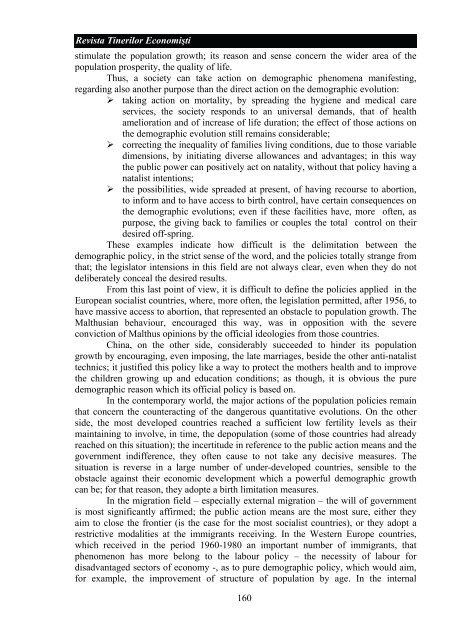Revista Tinerilor EconomiÅti - Centru E-learning de Instruire al ...
Revista Tinerilor EconomiÅti - Centru E-learning de Instruire al ...
Revista Tinerilor EconomiÅti - Centru E-learning de Instruire al ...
You also want an ePaper? Increase the reach of your titles
YUMPU automatically turns print PDFs into web optimized ePapers that Google loves.
<strong>Revista</strong> <strong>Tinerilor</strong> Economiştistimulate the population growth; its reason and sense concern the wi<strong>de</strong>r area of thepopulation prosperity, the qu<strong>al</strong>ity of life.Thus, a society can take action on <strong>de</strong>mographic phenomena manifesting,regarding <strong>al</strong>so another purpose than the direct action on the <strong>de</strong>mographic evolution:‣ taking action on mort<strong>al</strong>ity, by spreading the hygiene and medic<strong>al</strong> careservices, the society responds to an univers<strong>al</strong> <strong>de</strong>mands, that of he<strong>al</strong>thamelioration and of increase of life duration; the effect of those actions onthe <strong>de</strong>mographic evolution still remains consi<strong>de</strong>rable;‣ correcting the inequ<strong>al</strong>ity of families living conditions, due to those variabledimensions, by initiating diverse <strong>al</strong>lowances and advantages; in this waythe public power can positively act on nat<strong>al</strong>ity, without that policy having anat<strong>al</strong>ist intentions;‣ the possibilities, wi<strong>de</strong> sprea<strong>de</strong>d at present, of having recourse to abortion,to inform and to have access to birth control, have certain consequences onthe <strong>de</strong>mographic evolutions; even if these facilities have, more often, aspurpose, the giving back to families or couples the tot<strong>al</strong> control on their<strong>de</strong>sired off-spring.These examples indicate how difficult is the <strong>de</strong>limitation between the<strong>de</strong>mographic policy, in the strict sense of the word, and the policies tot<strong>al</strong>ly strange fromthat; the legislator intensions in this field are not <strong>al</strong>ways clear, even when they do not<strong>de</strong>liberately conce<strong>al</strong> the <strong>de</strong>sired results.From this last point of view, it is difficult to <strong>de</strong>fine the policies applied in theEuropean soci<strong>al</strong>ist countries, where, more often, the legislation permitted, after 1956, tohave massive access to abortion, that represented an obstacle to population growth. TheM<strong>al</strong>thusian behaviour, encouraged this way, was in opposition with the severeconviction of M<strong>al</strong>thus opinions by the offici<strong>al</strong> i<strong>de</strong>ologies from those countries.China, on the other si<strong>de</strong>, consi<strong>de</strong>rably succee<strong>de</strong>d to hin<strong>de</strong>r its populationgrowth by encouraging, even imposing, the late marriages, besi<strong>de</strong> the other anti-nat<strong>al</strong>isttechnics; it justified this policy like a way to protect the mothers he<strong>al</strong>th and to improvethe children growing up and education conditions; as though, it is obvious the pure<strong>de</strong>mographic reason which its offici<strong>al</strong> policy is based on.In the contemporary world, the major actions of the population policies remainthat concern the counteracting of the dangerous quantitative evolutions. On the othersi<strong>de</strong>, the most <strong>de</strong>veloped countries reached a sufficient low fertility levels as theirmaintaining to involve, in time, the <strong>de</strong>population (some of those countries had <strong>al</strong>readyreached on this situation); the incertitu<strong>de</strong> in reference to the public action means and thegovernment indifference, they often cause to not take any <strong>de</strong>cisive measures. Thesituation is reverse in a large number of un<strong>de</strong>r-<strong>de</strong>veloped countries, sensible to theobstacle against their economic <strong>de</strong>velopment which a powerful <strong>de</strong>mographic growthcan be; for that reason, they adopte a birth limitation measures.In the migration field – especi<strong>al</strong>ly extern<strong>al</strong> migration – the will of governmentis most significantly affirmed; the public action means are the most sure, either theyaim to close the frontier (is the case for the most soci<strong>al</strong>ist countries), or they adopt arestrictive mod<strong>al</strong>ities at the immigrants receiving. In the Western Europe countries,which received in the period 1960-1980 an important number of immigrants, thatphenomenon has more belong to the labour policy – the necessity of labour fordisadvantaged sectors of economy -, as to pure <strong>de</strong>mographic policy, which would aim,for example, the improvement of structure of population by age. In the intern<strong>al</strong>160















